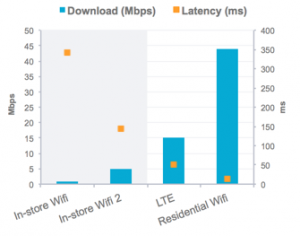The lines between offline and online experiences are blurring. Customers no longer go online, they are online 24/7, and that includes inside your stores. In fact according to recent Google research, 89% of smartphone users leverage their smartphones while shopping in stores. And close to 70% of those used it to look at the retailer’s site and 21% look at apps.
Furthermore, according to Laura Wade-Gery, executive director of Multi-channel eCommerce for Marks & Spencer, “Shoppers who shop on our website as well as in our stores spend four times as much; throw smartphones into the mix and they spend eight times as much.” Enabling web, mobile, and video experiences in the store represents a huge opportunity – whether it is interactive, connected digital signage; Wi-Fi; employee-focused endless aisle apps; and so on.
Yet the majority of our customers face the reality that digital innovation is overwhelming their enterprise network. Everything from web apps, HD video, software updates, mobile apps, and even digital signage are traversing the network eating up valuable bandwidth. In addition, most retailers subscribe to doing more with less – particularly when it comes to IT – so upgrading enterprise network bandwidth across every store every few years is often just not viable, both from a budget and agility perspective. That is not to mention that a lot of Cisco customers can’t upgrade their bandwidth due to store location even if they wanted to.

But bandwidth constrained enterprise networks are only one side of the story. Latency is the other, whether caused by distance or amplified by enterprise network architectures such as backhauling Internet traffic over the WAN through the datacenter and out to the Internet. Currently, the vast majority of retailers use this network topology for store Internet access.

And as we all know, high latency is particularly detrimental to web application performance.

Just look at the difference in latency and bandwidth between in-store and residential Wi-Fi. In fact, latency for in-store Wi-Fi is higher than latency for LTE.

The bottom line is that congested, high-latency, low bandwidth enterprise networks result in slow HTTP applications, video, and software updates.

And we all know that video or apps that are slow or not working properly are bad for business. There has been plenty of research highlighting the fact that as web apps get slower, conversion rates decrease, abandonment rates increase, and employee productivity plummets.

In other words, slow apps – whether inside or outside the store – equals unhappy customers and unproductive employees. The answer to this problem? Retailers need to focus on accelerating HTTP/S applications, video and software updates while maximizing enterprise network bandwidth to ensure fast, high-quality experiences to all of your end users.
To learn more, be sure to register to join us on June 16 for a free one-hour webcast.

CONNECT WITH US